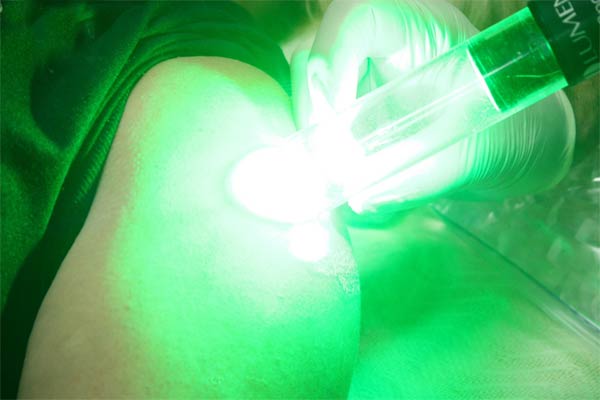
Laser Tattoo Removal
At Carolinas Dermatology of Columbia, SC, and Florence, SC, the VersaPulse laser is the gold standard for removing or lightening unwanted tattoos.
It is estimated that over 45 million Americans have professional, amateur, or homemade tattoos. Some studies have predicted that 50 percent of the people who have tattoos, will undergo various methods to remove them.
Tattoo removal methods include the following: local excision depending on the size and location of the tattoo; over the counter chemical bleaching products; surgically mechanized dermabrasion; and various forms of aggressive laser ablation technologies (such as super-pulsed Carbon Dioxide lasers) — all of which have drawbacks and limitations that can result in unfavorable outcomes for the patient.
However, with the advancements in technology over the last decade, the Lumenis VersaPulse laser has been considered the gold standard laser device to safely and effectively reduce or remove unwanted tattoos from the skin. At Carolinas Dermatology, we are proud to offer this state-of-the-art technology, highly trained technical clinicians, and various treatment recommendations that can help lighten or remove tattoo-ink pigment from the skin.
The Lumenis VersaPulse is a “versatile” laser system which incorporates 4 specific wavelengths of light. The VersaPulse laser offers 3 wavelengths of light that are considered Q-switched lasers. Q-switched lasers are a classification of lasers that emit light energy in nanosecond pulses. Q-switched lasers are rapid pulses of energy that are used to specifically target and fragment multiple colors of pigment or ink. The 4th wavelength of light that is offered by the VersaPulse laser is a HELP-G “High Energy Long Pulsed Green” 532nm spectrum of light. that treats a wide array of vascular lesion and conditions. Learn more about the Vp532nm laser.
The VersaPulse Laser offers 3 Q-switched lasers to treat multiple colors of tattoo-ink pigment: the Q-switched Nd:yag 1064nm, the Q-Switched 755nm, and the Q-switched 532nm.
This versatile platform of wavelengths allows the laser technician at Carolinas Dermatology to treat all colors of tattoo ink. The Q-switched 1064nm targets tattoo ink colors such as black, blue, green, brown and purple; The Q-switched 755nm targets black, green, and blue ink colors; and the Q-switched 532nm wavelength targets red, brown, orange, yellow, purple, green, and pink tattoo ink colors. As a result, virtually all colors of ink can be selectively targeted by the wavelengths utilized by the Lumenis VersaPulse laser.
Carolinas Dermatology has one of the most experienced laser tattoo removal technicians in South Carolina, Jonathan D. Gardner, to assist in the lightening or removing of unwanted tattoos.
Jonathan D. Gardner has been operating the Lumenis VersaPulse Laser to lighten or remove unwanted tattoos over the last 14 years. In fact, Jonathan and supervising Carolinas Dermatology’s Cosmetic Dermatologist, Dr. Annette Lynn, have been working together since 1999. Dr. Lynn was instrumental in training Jonathan, specifically on the various wavelengths included in the VersaPulse. Moreover, Jonathan has performed thousands of laser treatments, and has 14 years of vast, clinical experience, safely treating patients with various skin types and tattoo ink colors.
Jonathan Gardner works directly with our Board Certified Dermatologists at Carolinas Dermatology in Columbia, SC, and Florence, SC, to create a realistic treatment plan that ensures safe and reasonable outcomes for our patients.
Whether you are considering partial or complete tattoo removal, or you just need several treatments to lighten an old tattoo so a new one can be applied over the area, Jonathan has the knowledge and experience to help you through the VersaPulse laser treatment process. To schedule an appointment with Jonathan or to schedule a consultation with one of Carolina Dermatology’s licensed practitioners.
How does the Lumenis VersaPulse laser remove the tattoo?
Tattoo ink is a large foreign particle or structure that is mechanically placed into the skin. The VersaPulse laser emits a rapid burst of energy that is absorbed by the tattoo ink underneath the skin. Because this absorption of the laser’s energy (by the tattoo ink) is so quick (in nanoseconds), the targeted color is exploded into microscopic-sized ink particles. What was once a larger-sized ink particle has now been reduced to such a small size that the body’s immune system can now filter out the fragmented ink from the skin. Please note that this filtering process is not immediate: it will take several months for the body’s immune scavenger cells, called macrophages, to process the treated ink particles. Therefore, it will require multiple sessions of VersaPulse therapy to remove tattoo ink from the skin. Treatments can be repeated as early as 4 weeks, but spacing the treatments further apart in increments of 8 to 12 weeks apart allows the immune system more time to process the ink particles, AND it allows the skin more time to heal from the heat of the laser.
In general, It is a misconception that the “laser” is removing the tattoo. In actuality, the “body’s immune response” to the laser therapy is the actual mechanism for removing the ink from the skin. The laser is merely the tool of choice to safely and effectively recruit the body’s immune system into action.
There are many factors that can alter the progress of laser tattoo removal.
Yes, the VersaPulse laser uses the gold standard, Q-switched wavelengths of light to effectively target all tattoo ink colors; Yes, the physicians are highly skilled clinicians that are trained to provide the best dermatologic care available; And yes, the laser technician at Carolinas Dermatology, Jonathan D. Gardner, has over a decade of clinical expertise treating tattoos. But there are several unique factors that can greatly affect the outcome of laser tattoo removal.
Such factors include the following:
The color of ink used: For example, neon greens and neon blues are much more difficult to treat than black or red.
The density of the ink pigment in the skin or how heavy-handed the artwork is placed into the skin: Thick, layered, or stacked ink is harder to remove than thinly shaded, light, superficially placed ink.
The age of the tattoo: Older tattoos tend to have faded, naturally, over time, and are typically easier to remove than a newer, freshly placed tattoo.
Where the tattoo is located on the body: Lower extremity-placed tattoos are further away from the heart, and therefore healing tends to be slower. The body’s recruitment of macrophages tends to require more time for the filtering process to occur.
The size of the tattoo: the smaller the tattoo, the more efficient the body’s macrophages are, whereas a large tattoo, or multiple tattoo sites, require the body’s immune cells to focus, simultaneously, on the various treatment sites at once, slowing the filtering process.
The skin type or skin color: darker skin types, because they contain more color or melanin in the skin, typically requires more caution because the laser’s wavelength is attracted to the dark pigment in the skin AS WELL AS the tattoo ink. This is called a “competing chromophor” or competing color-target for the laser’s energy. Therefore, darker skin types can have greater healing issues such as hypo-pigmentation, post-inflammatory hyper-pigmentation, higher risk of scarring, and can not undergo repeat laser treatments as frequently as lighter or more fair-colored skin types. Please note that all skin types can undergo laser therapy for tattoo removal, but proper laser treatment parameters, extended periods between laser sessions, and wound-care protocols are crucial for successful outcomes.
The condition of the body’s immune system: Because the immune system is the most important variable to reducing the tattoo ink in the skin, the more robust and healthy the patient is, the more efficient the body can heal the treatment site and process the fragmented ink particles. Patients who have immunodeficiencies; or are taking immunosuppressive drugs; are malnourished; or are undergoing cancer treatments are at greater risks of unfavorable outcomes with laser treatments for tattoo removal.
How frequently the tattoo is treated: Treating the tattoo frequently is not going to remove a tattoo faster. In fact, treating a tattoo repeatedly, too soon, can increase the risk for scarring, hyper- and/or hypo-pigmentation, and ultimately increases the overall costs (over time) associated with the therapy. In short, The body needs time to heal and time to allow the macrophages to process the ink. The immune system can only work so fast, and it is possible to out-run your body’s ability to effectively remove the ink if treatments are performed too frequently. Treatment regimens can be determined based on each individuals set of circumstances, including the variables listed above, but in general, tattoo removal is a slow process that takes months to years to complete.
Pregnancy and laser tattoo removal: In general, the staff at Carolinas Dermatology does not recommend the VersaPulse Laser for tattoo removal during pregnancy, during lactation or nursing. Because the premise of laser tattoo removal is for the body to absorb and internally process the ink particles over time, the ink could potentially be ingested by the fetus, or by the infant through the nursing process.

Request Appointment
*This is a request form, not a guaranteed appointment. Upon receiving this completed form, we will contact you to confirm your actual appointment. If you need immediate assistance, please give us a call.







